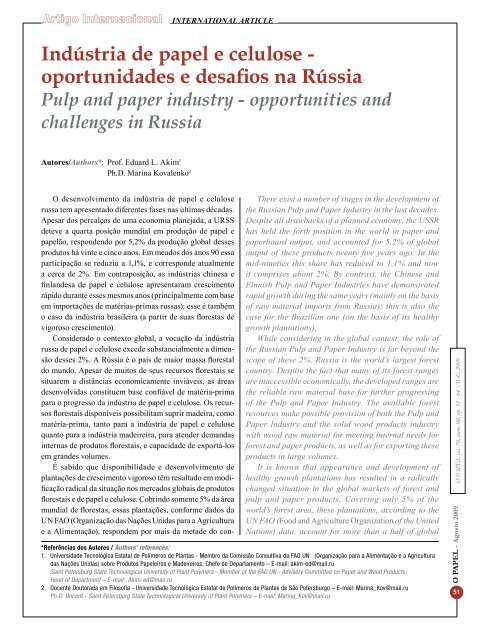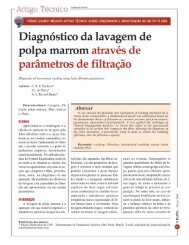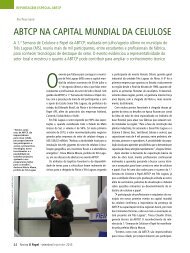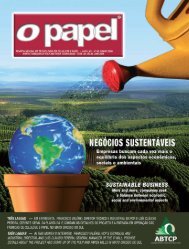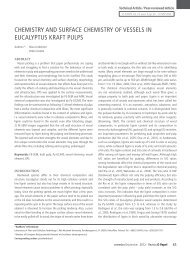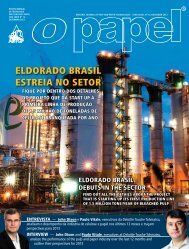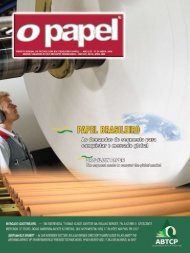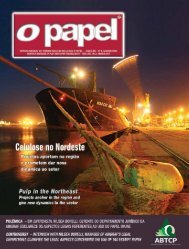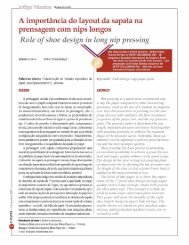Indústria de papel e celulose - oportunidades e ... - Revista O Papel
Indústria de papel e celulose - oportunidades e ... - Revista O Papel
Indústria de papel e celulose - oportunidades e ... - Revista O Papel
Create successful ePaper yourself
Turn your PDF publications into a flip-book with our unique Google optimized e-Paper software.
O PAPEL vol. 70, num. 08, pp. 51 - 64 AUG 2009O PAPEL - Agosto 200952Unida<strong>de</strong> / Unitsumo global <strong>de</strong> ma<strong>de</strong>ira. Em relação a isso, a afirmação <strong>de</strong>que a socieda<strong>de</strong> mo<strong>de</strong>rna seria incapaz <strong>de</strong> se manter sem osrecursos florestais da Rússia, on<strong>de</strong> concentram-se 22%-25%dos recursos florestais globais, po<strong>de</strong> ser problemática à primeiravista. Todavia, uma análise mais <strong>de</strong>talhada da situaçãomostrará que a disponibilida<strong>de</strong> <strong>de</strong> recursos florestais comfibra <strong>de</strong> coníferas do norte em combinação com mercadosvizinhos em <strong>de</strong>senvolvimento (russo, chinês, indiano), colocaa importância das florestas russas em alto nível. Enquantoa Europa discute problemas <strong>de</strong> mobilização da ma<strong>de</strong>ira, aquestão russa pren<strong>de</strong>-se à instalação <strong>de</strong> empresas para processamentoe conversão integrados da ma<strong>de</strong>ira nas regiõesimediatamente próximas a sua localização.A integração do complexo florestal russo, e da indústria<strong>de</strong> <strong>papel</strong> e <strong>celulose</strong> em particular, no sistema econômicoglobal se reflete no crescimento contínuo das exportações eimportações <strong>de</strong> produtos florestais, e no fato <strong>de</strong> o complexoflorestal russo (e a indústria <strong>de</strong> <strong>papel</strong> e <strong>celulose</strong>) ter assumidoorientação voltada à exportação, com o aparecimento <strong>de</strong>empresas globais <strong>de</strong> primeira gran<strong>de</strong>za (IP, SCA, Mondi-Neizidler, etc.) no setor florestal russo.Atualmente, só a indústria <strong>de</strong> <strong>papel</strong> e <strong>celulose</strong> russa estáligada ao setor privado, pois as florestas russas continuamproprieda<strong>de</strong> do estado. O gerenciamento florestal é implementadona base do arrendamento.O setor florestal da Fe<strong>de</strong>ração Russa apresenta potencialsurpreen<strong>de</strong>nte em termos <strong>de</strong> ulterior <strong>de</strong>senvolvimento. Ovolume crescente totaliza 89,3 bilhões <strong>de</strong> m³, com incrementoanual que exce<strong>de</strong> os 900 milhões <strong>de</strong> m 3 (Tabela 1). Essesrecursos representam mais <strong>de</strong> 20% do total global e o maiorvolume único nacional <strong>de</strong> recursos florestais. O potencialpara aumento do abate no âmbito <strong>de</strong> uma gestão florestal suswoodconsumption. In this connection, the statement thatthe mo<strong>de</strong>rn society would be unable to do without theRussia’s forest resources, where 22%-25% of the globalforest resources are concentrated, is problematical at firstglance. However, more <strong>de</strong>tailed analysis of the situationshows that the availability of forest resources containingnorthern reinforcing softwood fiber in combination withneighboring <strong>de</strong>veloping markets (Russian, Chinese,Indian) holds the importance of Russian forests at highlevel. Whereas Europe is discussing the problems ofwood mobilization, the Russian problem is constructingof enterprises for integrated in-<strong>de</strong>pth processing of woodin the immediate regions of its growth.The integration of the Russian Forest Complex,and the Pulp and Paper Industry in particular, into theglobal economic system is reflected in the continuousgrowth of forest products exports and imports; and thefact that the Russian Forest Complex (and the Pulpand Paper Industry) has become export–oriented withthe appearance of major global companies (IP, SCA,Mondi-Neizidler, etc.) in the Russian forest sector.Presently, the Russian Pulp and Paper Industryrelates to a private sector whereas the Russian forestsremain as state property. Forest management isimplemented on a rental basis.The forest sector of the Russian Fe<strong>de</strong>ration hasa staggering potential for further <strong>de</strong>velopment. Thegrowing stock amounts to 89.3 billion m³ with anannual increment exceeding 900 million m 3 (Table1). These resources represent over 20% of the globaltotal and the single largest national forest resource.The potential for increasing felling in the frameworkTabela 1. Dados gerais dos recursos florestais da Fe<strong>de</strong>ração Russa / Table 1. General indices of forest resources of the Russian Fe<strong>de</strong>rationÁrea <strong>de</strong> florestas / Forest land areaÁrea disponível / Stocked areaDisponível em crescimento, totalGrowing stock, totalmadura e excessivamente madura, das quais:Mature and over mature of which:Coníferas / ConiferousNão-coníferas / Non-coniferousIncremento anual médio totalTotal average annual incrementmilhões <strong>de</strong> hamillion hamilhões <strong>de</strong> hamillion haFe<strong>de</strong>ração Russa, totalRussian Fe<strong>de</strong>ration, totalParte europeiaEuropean part%Parte asiáticaAsian part890,8 174,2 19,6 716,6 80,4796,2 179,3 22,5 625,9 77,5bilhões <strong>de</strong> m 3billion m 3 83,3 22,9 27,5 60,4 72,5bilhões <strong>de</strong> m 3billion m 3 44,3 12,7 28,7 31,6 71,3bilhões <strong>de</strong> m 3billion m 3 34,2 8,0 23,4 26,2 76,6bilhões <strong>de</strong> m 3billion m 3 9,5 3,3 34,7 6,2 65,3milhões <strong>de</strong> m 3million m 3 993,8 377,2 38,0 616,6 62,0Corte anual permissívelmilhões <strong>de</strong> m 3Annual allowable cutmillion m 3 635,0 313,2 49,3 321,8 50,7Fontes: OAO «NIPIEILesprom», 2009; «Estudo <strong>de</strong> perspectivas do setor florestal da Fe<strong>de</strong>ração Russa». UNECE - FAO UN, ECE/TIM/DP/27, Genebra, 2003.Sources: OAO «NIPIEILesprom», 2009; «Russian Fe<strong>de</strong>ration forest sector outlook study». UNECE - FAO UN, ECE/TIM/DP/27, Geneva, 2003.%
tentável é evi<strong>de</strong>nte. Além disso, a Rússia possui recursos <strong>de</strong>mão <strong>de</strong> obra muito capaz e <strong>de</strong> baixo custo. Ambos os fatorespo<strong>de</strong>riam atrair investimentos para o setor florestal russo.Os importantes <strong>de</strong>sdobramentos da política florestal doperíodo <strong>de</strong> 2004-2009 na Rússia foram:• A ratificação do Protocolo <strong>de</strong> Kioto pela Rússia (comentrada em vigor na primavera <strong>de</strong> 2005, marcada pornovos esforços no sentido <strong>de</strong> monitorar as emissões <strong>de</strong>carbono).• O ingresso da Rússia na UN FAO.• A entrada em vigor <strong>de</strong> nova Legislação Florestal – CódigoFlorestal (todas as florestas são <strong>de</strong> exclusiva proprieda<strong>de</strong>do Estado).• Todas as fábricas <strong>de</strong> <strong>papel</strong> e <strong>celulose</strong> são parte <strong>de</strong> umsetor privado.• Estabelecimento do Conselho do Complexo <strong>de</strong> Silvicultura,chefiado pelo primeiro Vice-Primeiro-Ministro, V. Zubkov.• Formação <strong>de</strong> uma nova associação entrea International Paper e a Ilim Pulp Enterprise, e o início<strong>de</strong> suas ativida<strong>de</strong>s em outubro <strong>de</strong> 2007.• O uso <strong>de</strong> monitoração espacial por satélite, para prevenircortes ilegais <strong>de</strong> ma<strong>de</strong>ira.• Programas <strong>de</strong> investimento começaram a ser implementados.• A Agência Fe<strong>de</strong>ral <strong>de</strong> Silvicultura, estrutura-chave do gerenciamentoflorestal, sendo parte integrante do Ministério<strong>de</strong> Recursos Naturais, foi incorporada ao Ministério daAgricultura em maio <strong>de</strong> 2008.• Modificação na dimensão das exportações <strong>de</strong> produtosflorestais e <strong>papel</strong>eiros causada pela crise econômica global,e alteração da taxa <strong>de</strong> câmbio do rublo em relaçãoao euro e US$.• A <strong>de</strong>cisão tomada pelo governo da Fe<strong>de</strong>ração Russa emfins <strong>de</strong> 2008 sobre a adoção <strong>de</strong> novo nível <strong>de</strong> impostos<strong>de</strong> exportação sobre ma<strong>de</strong>ira redonda (novos níveis <strong>de</strong>impostos <strong>de</strong> exportação sobre ma<strong>de</strong>ira redonda em 2007-2009-2011, implementação do <strong>de</strong>creto governamentaln° 75 <strong>de</strong> fevereiro <strong>de</strong> 2007 referente a aumento gradual<strong>de</strong>sse imposto <strong>de</strong> exportação. Manifestação <strong>de</strong> reaçõesheterogêneas à medida foram realizadas no mundo, e umanegativa nos países nórdicos).• Estabelecimento da Plataforma Tecnológica <strong>de</strong> SilviculturaRussa e sua conexão com a Plataforma Tecnológica<strong>de</strong> Silvicultura Europeia.• Fechamento da Baikal’s Pulp Mill (2008).ProduçãoTanto a <strong>de</strong>manda como a produção <strong>de</strong> produtos <strong>de</strong> <strong>papel</strong>e <strong>celulose</strong> aumentaram na Rússia durante o período <strong>de</strong>2004-2007, que se esten<strong>de</strong>u ao primeiro semestre <strong>de</strong> 2008.Contudo, na segunda meta<strong>de</strong> <strong>de</strong> 2008 houve queda bruscana produção <strong>de</strong> <strong>papel</strong> e <strong>celulose</strong> e <strong>de</strong> <strong>papel</strong>ão (Tabela 2). Esseof sustainable forest management is clear. Further,Russia possesses rather well educated, low-cost laborresources. Both factors could attract investments intothe Russian forest sector.The important forest sector policy <strong>de</strong>velopments in2004-2009 in Russia were as follows:• The Kyoto Protocol ratification by Russia (and itscoming into effect in spring of 2005 with new effortsto monitor carbon emissions).• Russia’s entry into UN FAO.• Entry into force of a new Forest Legislation – ForestCo<strong>de</strong> (All Forests are only State owns).• All pulp and paper mills are part of a privatesector.• Establishment of the Forestry Complex Councilhea<strong>de</strong>d by the first Vice Premier Minister, V.Zubkov.• A new alliance formation between"International Paper" and "Ilim Pulp Enterprise",and commencement of its activities in October2007.• The use of space satellite monitoring for preventingillegal timber cuttings.• Investment programs started to be implemented.• The Fe<strong>de</strong>ral Agency of Forestry, the key structureof forest management, being a constituent ofthe Ministry of Natural Resources, has beenincorporated into the Ministry of Agriculture inMay 2008.• Changing structure of forest and paper exports causedby the global economic crisis, and changed exchangerate of the Ruble as related to Euro and USD;• Decision ma<strong>de</strong> by the RF Government in late2008 in introducing a new level of export dutieson round wood (new level of export duty on roundwood in 2007-2009-2011, implementation ofthe Government <strong>de</strong>cree n.75 of February 2007concerning stage-by-stage increase in export taxon round wood. Dissimilar reaction to this actionwas <strong>de</strong>monstrated in the world, and a negative onein Nordic countries).• Establishment of the Russian Forestry TechnologicalPlatform and its connection with the EuropeanForestry Technological Platform.• Shutdown of the Baikal’s Pulp Mill (2008).outputBoth <strong>de</strong>mand and output of pulp and paper productsincreased in Russia through 2004-2007 and into thefirst half of 2008. However, in the second half of2008 there was a slump in production of both pulpO PAPEL - Agosto 2009 O PAPEL vol. 70, num. 08, pp. 51 - 64 AUG 200953
etrocesso da produção continuou no período <strong>de</strong> janeiro amarço <strong>de</strong> 2009 (Tabela 3).Devido à relativa estabilida<strong>de</strong> econômica e política estabelecidano país <strong>de</strong>s<strong>de</strong> a principal revalorização da moeda em1998 e a uma política macroeconômica mais expansionistadurante 1999, tem havido contínuo aumento da produção <strong>de</strong><strong>celulose</strong>, <strong>papel</strong> e <strong>papel</strong>ão na Rússia (Tabela 2) tendo mais doque duplicado <strong>de</strong>s<strong>de</strong> 1996, embora a produção ainda tenha <strong>de</strong>voltar aos níveis recor<strong>de</strong> previamente registrados nos períodos<strong>de</strong> pré-transição <strong>de</strong> 1988-1989 (final da era soviética).No período <strong>de</strong> 2007-2008, o setor <strong>de</strong> <strong>papel</strong> e <strong>celulose</strong> russocontinuou a expandir a produção <strong>de</strong> <strong>celulose</strong>, <strong>papel</strong> e <strong>papel</strong>ão,particularmente a produção <strong>de</strong> <strong>papel</strong>ão para embalagens.Durante o ano <strong>de</strong> 2007 a produção total <strong>de</strong> <strong>celulose</strong> da Rússiaand paper & paperboard (Table 2). This setback inproduction has been continued also in January-March2009 (Table 3).Owing to relative economic and political stabilityestablished in the country since the major currencyrevaluation in 1998, and more expansionary macroeconomicpolicy in year 1999, there has been a continuous increasein output of pulp, paper and paperboard in Russia (Table2), more than doubling since 1996, although output has yetto reach previous record levels of 1988-1989 pre-transitionperiods (in the late Soviet era).In 2007-2008, the Russian pulp and paper sectorcontinued to expand production of pulp, paper andpaperboard, particularly the output of paperboard forTabela 2. Produção <strong>de</strong> <strong>celulose</strong>, <strong>papel</strong> e <strong>papel</strong>ão na Fe<strong>de</strong>ração Russa em 1988, 1996 – 2008 (em milhares <strong>de</strong> toneladas)Table 2. Output of pulp, paper and paperboard in the Russian Fe<strong>de</strong>ration in 1988, 1996 – 2008 (thousand metric tons)O PAPEL vol. 70, num. 08, pp. 51 - 64 AUG 2009ProdutosProductsTotal <strong>de</strong> polpa químicaChemical pulp, total:Celulose <strong>de</strong> mercadoMarket pulp<strong>Papel</strong> e <strong>papel</strong>ãoPaper and paperboardTotal <strong>de</strong> <strong>celulose</strong> <strong>de</strong> mercado,<strong>papel</strong> e <strong>papel</strong>ãoTotal market pulp, paperand paperboardTotal <strong>de</strong> <strong>papel</strong>,incluindo:Paper total including:<strong>Papel</strong>-jornalNewsprint<strong>Papel</strong> offsetOffset paperTotal <strong>de</strong> <strong>papel</strong>ãoPaperboard total:Total <strong>de</strong> <strong>papel</strong>ãoonduladoCorrugated board, total1988(89)1996 1997 1998 1999 2000 2001 2002 2003 2004 2005 2006 2007 20088331 3028 3170 3205 4225 4960 5272 5568 5764 5922 5933 6005 5973 5880 98.43076 1144 1169 1320 1722 2018 2136 2233 2311 2409 2419 2380 2421 2287 94.58632 3236 3269 3426 4535 5300 5595 5921 6227 6619 6800 7145 7382 7466 101.211708 4380 4438 4746 6257 7318 7731 8154 8538 9028 9219 9525 9730 9753 100.25465 2274 2179 2325 2966 3320 3415 3524 3682 3903 3969 4004 4084 3982 97.51693 1243 1201 1386 1622 1694 1732 1713 1814 1978 2007 1993 1982 1988 100.5396 349 337 399 485 461 465 491 449 469 452 466 455 427 93.73167 962 1090 1102 1569 1980 2180 2397 2545 2716 2830 3141 3249 3483 105.61639 610 775 760 1080 1356 1530 1711 1882 2090 2102 2332 2499 2699 108.0Fontes: Comitê Estatístico Estatal da Fe<strong>de</strong>ração Russa; PPB-express, processamento <strong>de</strong> dados do autor / Sources: Goscomstat of the Russian Fe<strong>de</strong>ration; PPB-express, author's data handlingTabela 3. Produção <strong>de</strong> <strong>celulose</strong>, <strong>celulose</strong> <strong>de</strong> mercado, <strong>papel</strong> e <strong>papel</strong>-jornal na Fe<strong>de</strong>ração Russa, <strong>de</strong> outubro <strong>de</strong> 2008 a março <strong>de</strong> 2009 (%)Table 3. Output of pulp, market pulp, paper and newsprint in the Russian Fe<strong>de</strong>ration from October 2008 to March 2009 (%)2008/2007(%)O PAPEL - Agosto 200954Código produtosProducts co<strong>de</strong>Total <strong>de</strong> polpa química <strong>de</strong> mercadoChemical pulp, totalCelulose <strong>de</strong> mercadoMarket pulpTotal <strong>de</strong> <strong>papel</strong>Paper, total<strong>Papel</strong>-jornalNewsprint10.200810.200711.200811.200712.200812.200701.200901.200802.200902.200803.200903.200892.0 78.3 76.0 68.6 77.2 91.894.5 54.3 70.7 67.5 71.0 83.193.7 94.3 87.0 81.1 88.5 95.6103.2 105.4 101.3 102.6 98.3 100.1
(incluindo <strong>celulose</strong> para <strong>papel</strong> e <strong>papel</strong>ão e <strong>celulose</strong> <strong>de</strong> mercado)diminuiu em 0,9%, a produção <strong>de</strong> <strong>celulose</strong> <strong>de</strong> mercadoaumentou em 1,6%, e a <strong>de</strong> <strong>papel</strong> e <strong>papel</strong>ão em 2,3%, incluindoum aumento <strong>de</strong> 4,2% na produção <strong>de</strong> <strong>papel</strong>ão. O consumo percapita <strong>de</strong> <strong>papel</strong> e <strong>papel</strong>ão em 2008 foi <strong>de</strong> 53,0 kg/ano.ExportaçõesAs exportações <strong>de</strong> produtos <strong>de</strong> ma<strong>de</strong>ira <strong>de</strong>têm posição dominanteno total das exportações russas <strong>de</strong> produtos <strong>de</strong> baseflorestal, e a estrutura global das exportações <strong>de</strong>sses produtosainda apresenta caráter pronunciado <strong>de</strong> matéria-prima.Durante os últimos 10 a 20 anos as exportações <strong>de</strong> ma<strong>de</strong>iraredonda da Rússia para a Finlândia mais que dobraram,e para a China cresceram muitas vezes. No mesmo período,a produção <strong>de</strong> <strong>papel</strong> e <strong>papel</strong>ão dobrou na Finlândia e semultiplicou na China.Em fevereiro <strong>de</strong> 2007 o governo russo assinou a Resolução75, referente a novos níveis <strong>de</strong> impostos <strong>de</strong> exportação sobrema<strong>de</strong>ira redonda para o período 2007-2011. Espera-se que atarifa <strong>de</strong> exportação sobre toras serradas aumente <strong>de</strong> €4 ($6)por m 3 em 2006 para o patamar proibitivo <strong>de</strong> €50 ($77) por m 3em 2009. Em 2011 espera-se que esse patamar <strong>de</strong> impostos,isto é, €50 por m 3 , também seja aplicado a ma<strong>de</strong>ira <strong>de</strong> bétulapara polpação. Atualmente, quantida<strong>de</strong>s significativas <strong>de</strong>packaging. During 2007, Russia’s total output of pulp(both pulp for paper and paperboard and market pulp)<strong>de</strong>creased by 0.9%, the output of market pulp increasedby 1.6%, and the output of paper and paperboardincreased by 2.3%, including a 4.2% increase in outputof paperboard. Paper and paperboard consumption percapita in 2008 was 53.0 kg/year.ExportsExports of solid wood products hold a dominantposition in the total Russian exports of forest-basedproducts, and the overall structure of forest productexports still has a pronounced raw material character.For the last 10−20 years, there was more than atwo-fold increase in round wood exports from Russiato Finland, and many times that to China. Output ofpaper and board within the same period in Finlandhas doubled, and many times in China.In February 2007, the Russian Governmentsigned into law Resolution 75 with new levels ofexport taxes on round wood in 2007-2011. Theexport tariff on saw logs is expected to increasefrom €4 ($6) per m 3 in 2006 to the prohibitive levelof €50 ($77) per m 3 in 2009. In 2011 this level ofTabela 4. Estrutura das exportações russas <strong>de</strong> produtos <strong>de</strong> base florestal <strong>de</strong> 1990 a 2008Table 4. Structure of Russian exports of forest-based products from 1990 to 20081990 1998 1999 2000 2001 2002 2003 2004 2005 2006 2007 2008Ma<strong>de</strong>ira redonda, milhões <strong>de</strong> m 3Round wood, million m 3 31.4 20.0 27.6 31.3 31.7 36.5 37.6 41.5 48.0 51.0 49.3 36.8Ma<strong>de</strong>ira serrada, milhões <strong>de</strong> m 3Sawn wood, million m 3 15.7 4.6 6.4 7.9 7.7 8.9 11.0 13.1 14.8 16.8 17.3 14.2Equivalente a ma<strong>de</strong>ira redonda 1 , milhões <strong>de</strong>m 3 / In terms of round wood 1 , million m 325.1 7.36 10.2 12.6 12.3 14.2 17.6 20.96 24.64 26.88 27.68 22.72Celulose <strong>de</strong> mercado, milhões <strong>de</strong> toneladasMarket pulp, million tons0.993 1.056 1.373 1.600 1.758 1.885 1.905 1.866 1.952 1.896 1.900 1.914<strong>Papel</strong> e <strong>papel</strong>ão, milhões <strong>de</strong> toneladasPaper and paperboard, million tons2.761 1.767 2.048 2.309 2.353 2.500 2.550 2.590 2.700 2.552 2.590 2.642Celulose, <strong>papel</strong> e <strong>papel</strong>ão, milhões <strong>de</strong>toneladas / Pulp, paper and paperboard, 3.74 2.823 3.421 3.909 4.111 4.385 4.455 4.456 4.652 4.448 4.490 4.556million tonsEquivalente a ma<strong>de</strong>ira redonda 2 , milhões <strong>de</strong>m 3 / In terms of round wood 2 , million m 3 12.7 9.57 11.6 13.3 13.94 14.87 15.10 15.11 15.77 15.08 15.22 15.44Total <strong>de</strong> exportações <strong>de</strong> produtos florestaise <strong>papel</strong>eiros equivalente a ma<strong>de</strong>ira redonda,milhões <strong>de</strong> m 3 / / Total exports of forest and 69.2 36.9 49.4 57.2 58.0 65.6 70.30 77.57 88.41 92.96 92.20 74.96million m 3paper products in terms of round wood,Porcentagem <strong>de</strong> <strong>celulose</strong>, <strong>papel</strong> e <strong>papel</strong>ãoequivalente a ma<strong>de</strong>ira redonda / Percentageof pulp, paper and paperboard in terms of18.4 25.9 23.5 23.3 24.0 22.7 21.5 19.5 17.8 16.2 16.5 20.6round woodPorcentagem <strong>de</strong> exportações <strong>de</strong> ma<strong>de</strong>ira redonda/ Percentage of round wood exports45% 54% 56% 55% 55% 56% 53% 53.5% 54.3% 54.8% 53.5% 49.1%1O fator usado é 1,6 - fonte: UN FAO / Factor used is 1,6 - source: UN FAO2O fator usado é 3,39 - fonte: UN FAO / Factor used is 3,39 - source: UN FAOO PAPEL - Agosto 2009 O PAPEL vol. 70, num. 08, pp. 51 - 64 AUG 200955
étula para polpação são exportadas para a Finlândia, e essasfuturas tarifas, se aprovadas, irão certamente interromper essecomércio. Impostos sobre exportações <strong>de</strong> ma<strong>de</strong>ira redondaconstituíram tema próprio nas conversações sobre o ingressoda Rússia na OMC (Organização Mundial do Comércio) e apreparação <strong>de</strong> um novo acordo entre UE e Rússia.No período <strong>de</strong> 2004-2008 as exportações <strong>de</strong> produtos <strong>de</strong><strong>papel</strong> e <strong>celulose</strong> continuaram a crescer (Tabela 5, Figura 1). Asexportações <strong>de</strong> <strong>celulose</strong>, <strong>papel</strong> e <strong>papel</strong>ão estavam aumentandoprogressivamente <strong>de</strong>s<strong>de</strong> 1990, tendo atingido o pico em 2005.No entanto, as exportações russas, expressas como porcentagemda produção, permaneceram em larga medida inalteradas<strong>de</strong>s<strong>de</strong> 1996, com as exportações compreen<strong>de</strong>ndo cerca <strong>de</strong> 80%da produção para <strong>celulose</strong> <strong>de</strong> mercado, e aproximadamente40% da produção para <strong>papel</strong> e <strong>papel</strong>ão. (Tabela 5, Figura 2).Os principais <strong>de</strong>stinos para esses produtos russos são a China(<strong>celulose</strong> <strong>de</strong> mercado, kraftliners), Irlanda (<strong>celulose</strong> <strong>de</strong> mercaexporttaxes, i.e., €50 per m 3 , is also expected to beapplied to birch pulpwood. Significant quantities ofbirch pulpwood are currently exported to Finland,and these future export tariffs, if enacted, willundoubtedly disrupt the tra<strong>de</strong>. Duties on roundwood exports were a focus of the talks on Russiajoining WTO and preparation of a new EU – Russiaagreement.In 2004-2008, exports of pulp and paper productscontinued to increase (Table 5, Figure 1). Exportsof pulp, paper and paperboard were progressivelyincreasing since 1990 and reached a peak level in 2005.However, Russian exports as a percentage of productionhave remained largely unchanged since 1996, withexports comprising to about 80% of output for marketpulp, and around 40% for paper and paperboard.(Table 5, Figure 2). Major export <strong>de</strong>stinations forTabela 5. Exportações <strong>de</strong> <strong>celulose</strong> <strong>de</strong> mercado, <strong>papel</strong> e <strong>papel</strong>ão da URSS (1980 − 1990) e da Rússia (1993 − 2008), em milhares <strong>de</strong> toneladas métricasTable 5. Exports of market pulp, paper and paperboard from the USSR (1980 − 1990) and from Russia (1993 − 2008), thousand metric tonsAnoYearProduçãoOutputCelulose <strong>de</strong> mercado / Market pulpExportaçõesExportsPorcentagem das exportaçõesPercentage of exportsProduçãoOutput<strong>Papel</strong> e <strong>papel</strong>ão / Paper and paperboardExportaçõesExportsPorcentagem das exportaçõesPercentage of exports1980 2457 821 33,5 8688 1018 11,71983 2840 1012 35,6 9556 1034 10,81986 3233 1105 34,1 10395 1188 11,41987 3371 1088 32,3 10566 1252 11,9O PAPEL vol. 70, num. 08, pp. 51 - 64 AUG 20091990 3255 600 18,4 8325 900 10,81992 2109 856 40,6 5750 1568 27,31993 1682 1077 64,0 4462 1418 31,81994 1328 1028 77,4 3410 1264 37,11995 1736 1362 78,5 4070 1690 41,51996 1267 1095 85,7 3220 1380 42,91997 1193 1008 82,8 3331 1507 45,21998 1311 1056 75,8 3540 1783 50,41999 1725 1350 78,3 4467 2019 45,22000 2000 1635 81,8 5239 2355 45,02001 2136 1753 82,1 5595 2350 42,0O PAPEL - Agosto 20092002 2233 1866 83,6 5921 2453 41,42003 2301 1905 82,8 6174 2550 41,32004 2404 1866 77,6 6653 2590 38,92005 2429 1952 80,4 6948 2700 38,92006 2379 1896 79,7 7145 2552 35,72007 2421 1900 78,5 7382 2590 35,1562008 2287 1914 83,7 7466 2642 35,4Fontes: Comitê Estatístico Estatal da URSS, Comitê Estatístico Estatal da Fe<strong>de</strong>ração Russa; PPB-express, Moscou, processamento <strong>de</strong> dados do autorSources: Goscomstat of the USSR, Goscomstat of the Russian Fe<strong>de</strong>ration; PPB-express, Moscow, author’s data handling
Celulose <strong>de</strong> mercado / Market pulp<strong>Papel</strong> e <strong>papel</strong>ão / Paper and paperboardFigura 1. Exportações <strong>de</strong> <strong>celulose</strong> <strong>de</strong> mercado, <strong>papel</strong> e <strong>papel</strong>ão da URSS e da Rússia, em milhares <strong>de</strong> toneladas métricasFigure 1. Exports of market pulp, paper and paperboard from the USSR and Russia, thousand metric tonsCelulose <strong>de</strong> mercado / Market pulp<strong>Papel</strong> e <strong>papel</strong>ão / Paper and paperboardFigura 2. Exportações compartilhadas <strong>de</strong> <strong>celulose</strong> <strong>de</strong> mercado, <strong>papel</strong> e <strong>papel</strong>ão da URSS e da Rússia, em %Figure 2. Share exports of market pulp, paper & paperboard from the USSR and from Russia, %do, kraftliners), Índia (<strong>papel</strong>-jornal) e Turquia (<strong>papel</strong>-jornal).Embora a tonelagem das exportações russas <strong>de</strong> <strong>papel</strong> e<strong>papel</strong>ão exceda em larga medida a tonelagem das importações,a balança comercial em valor tem-se mantido em<strong>de</strong>terioração, pois a Rússia tem expandido importaçõesthese Russian products are China (market pulp, kraftlinerboard), Ireland (market pulp, kraft linerboard),India (newsprint), and Turkey (newsprint).Although the tonnage of Russian paper and paperboar<strong>de</strong>xports greatly exceed the tonnage of imports, the tra<strong>de</strong>O PAPEL - Agosto 2009 O PAPEL vol. 70, num. 08, pp. 51 - 64 AUG 200957
<strong>de</strong> produtos <strong>papel</strong>eiros <strong>de</strong> maior valor. O déficit comercialanual em termos <strong>de</strong> <strong>papel</strong> e <strong>papel</strong>ão tem sido negativo<strong>de</strong>s<strong>de</strong> 2001, e em 2008 superou os US$ 2 bilhões (Tabelas6 e 7, Figura 3). O maior valor das importações <strong>de</strong> <strong>papel</strong> e<strong>papel</strong>ão comparado ao valor das exportações correspon<strong>de</strong>ntes<strong>de</strong>ve-se principalmente ao fato <strong>de</strong> a Rússia importarprodutos mais caros, tais como materiais <strong>de</strong> alta qualida<strong>de</strong>para caixas e embalagens, papéis revestidos e tissue, aopasso que commodities menos dispendiosas como <strong>papel</strong>jornale kraftliner são as exportadas.O setor florestal orientado para exportação da Rússia e aestrutura predominante <strong>de</strong> exportações <strong>de</strong> matérias-primasfizeram com que a crise econômica global exercesse gran<strong>de</strong>balance in value has continued to <strong>de</strong>teriorate, as Russiahas expan<strong>de</strong>d imports of higher value paper products.The annual tra<strong>de</strong> <strong>de</strong>ficit in paper and paperboard hasbeen negative since 2001, and in 2008 it was more thana 2 billion USD (Tables 6, 7, Figure 3). The higher valueof imports of paper and paperboard as compared to theirexports is mainly due to the fact that Russia is importingrather expensive products, such as high quality materialsfor container and packaging, coated paper, and tissues,whereas less expensive commodity products, such asnewsprint and kraft linerboard, are being exported.The export-oriented forest sector of Russia andprevailing raw material structure of exports have led toTabela 6. Exportações e importações russas <strong>de</strong> <strong>papel</strong> e <strong>papel</strong>ão no período <strong>de</strong> 2000−2008 (em milhões <strong>de</strong> US$)Table 6. Russian exports and imports of paper and paperboard in 2000−2008 (million USD)Exportações / Exports Importações / Imports Balança comercial / Tra<strong>de</strong> balance2000 920 731 +1892001 927 1012 −852002 887 1200 −3132003 967 1465 -4982004 1184 1774 -5902005 1331 2107 -8762006 1428 2547 -11192007 1599 3246 -16472008 1792 3878 -2086Fontes: Comitê Estatal Aduaneiro, revista sobre <strong>celulose</strong>, <strong>papel</strong> e <strong>papel</strong>ão; PPB-Express, PPB exportações; PPB importações; processamento <strong>de</strong> dados do autor.Sources: State Customs Committee; pulp, paper, and board magazine, PPB-express, PPB exports, PPB imports; author’s data handlingO PAPEL vol. 70, num. 08, pp. 51 - 64 AUG 2009Tabela 7. Exportações e importações russas <strong>de</strong> <strong>celulose</strong>, <strong>papel</strong> e <strong>papel</strong>ão no período <strong>de</strong> 2006−2008 (em milhões <strong>de</strong> US$)Table 6. Russian exports and imports of pulp, paper and paperboard in 2006−2008 (million USD)O PAPEL - Agosto 2009Exportações / Exports Importações / Imports Balança comercial / Tra<strong>de</strong> balance2006 2279 (851+1428) 2589 (42+2547) -3102007 2658 (1059+1599) 3319 (73+3246) -6612008 2972 (1180+1792) 3947 (69+3878) -975Fontes: Comitê Estatal Aduaneiro; revista sobre <strong>celulose</strong>, <strong>papel</strong> e <strong>papel</strong>ão; PPB-express, PPB exportações; PPB importações; processamento <strong>de</strong> dados do autorSources: State Customs Committee; pulp, paper, and board magazine; PPB-express, PPB exports, PPB imports, author’s data handlingExportações / ExportsImportações / ImportsBalança comercial / Tra<strong>de</strong> balance58Figura 3. Exportações e importações russas <strong>de</strong> <strong>papel</strong> e <strong>papel</strong>ão, <strong>de</strong> 2000 a 2008 / Figure 3. Russia exports and imports of paper and paperboard, 2000-2008
impacto sobre o complexo silvicultural russo como um todo.No final <strong>de</strong> 2008 e início <strong>de</strong> 2009 ocorreu mudança drástica,tanto na estrutura das exportações <strong>de</strong> produtos florestais e<strong>papel</strong>eiros quanto no mercado interno. A queda abrupta daprodução industrial nos países importadores <strong>de</strong> ma<strong>de</strong>ira redondarussa aliada ao aumento <strong>de</strong> impostos sobre exportaçõesresultou em redução das exportações <strong>de</strong> ma<strong>de</strong>ira, sobretudopara a Finlândia. A redução do consumo <strong>de</strong> artigos <strong>de</strong> conveniêncianos EUA e na Europa Oci<strong>de</strong>ntal levou à redução <strong>de</strong>suas produções na China e, consequentemente, a uma reduçãodo consumo <strong>de</strong> <strong>papel</strong> e <strong>papel</strong>ão para embalagens. O aumentodos estoques <strong>de</strong> <strong>celulose</strong> <strong>de</strong> mercado causado por esses fatoresultou em queda dos preços da <strong>celulose</strong> no mercado global eem drástica contração simultânea das exportações <strong>de</strong> <strong>celulose</strong><strong>de</strong> mercado da Rússia para a China. Também ocorreu reduçãodas exportações <strong>de</strong> kraftliner para a China.Ao mesmo tempo, <strong>de</strong>vido a mudanças na taxa <strong>de</strong>câmbio do rublo em relação ao euro e US$ (Tabela 8),aumentou a competitivida<strong>de</strong> <strong>de</strong> uma série <strong>de</strong> produtos(<strong>papel</strong> <strong>de</strong> escritório, <strong>papel</strong>-jornal, etc.), nos mercadosinterno e também externo.Nos últimos anos o <strong>papel</strong> tissue foi responsável por mais<strong>de</strong> 20% do total das importações russas <strong>de</strong> <strong>papel</strong> e <strong>papel</strong>ão.A alteração da taxa <strong>de</strong> câmbio do rublo tem contribuídopara uma produção crescente <strong>de</strong>sse tipo <strong>de</strong> <strong>papel</strong> na Rússia.Novas capacida<strong>de</strong>s foram postas em operação na SyasskyPulp and Paper Mill em 2008, em Syktyvkar. Há planos parase pôr em funcionamento uma empresa da SCA Companynão longe <strong>de</strong> Moscou.A crise econômica atual causou a suspensão <strong>de</strong> uma série<strong>de</strong> projetos tidos como prioritários, <strong>de</strong>senvolvidos nos últimosanos e orientados para o processamento intensivo da ma<strong>de</strong>iraem regiões <strong>de</strong> crescimento <strong>de</strong> árvores.Atualmente, a maior empresa russa produziu 75%da <strong>celulose</strong> <strong>de</strong> mercado, 80% do <strong>papel</strong> e 50% do <strong>papel</strong>ão(Tabela 9). Em outubro <strong>de</strong> 2006 foi anunciada a formaçãothe fact that the global economic crisis has had a greatimpact on the Russia’s Forestry Complex as a whole.In late 2008 – early 2009, a drastic change took placeboth in the structure of exports, of forest and paperproducts, and in the internal market. The slump inindustrial production in the countries importing Russianround wood coupled with increased duties on exportshas resulted in <strong>de</strong>crease in round wood exports, mainlyto Finland. Decreased consumption of conveniencegoods in the USA and West Europe led to <strong>de</strong>crease suchproductions in China, and, as a result, to a <strong>de</strong>creasedconsumption of packaging paper and paperboard. Theincrease in market pulp inventories caused by this facthas resulted in a drop of global market pulp prices, andin simultaneous drastic shrinkage of market pulp exportsfrom Russia to China. Reduction in kraftliner exports toChina has also occurred.At the same time, because of changes in exchangerate of the Ruble as related to Euro and USD (Table 8),competitiveness of a number of products has increased(office paper, newsprint, etc.) both in the internal an<strong>de</strong>xternal markets.In recent years, tissue paper was responsible formore than 20% of the total paper and paperboardimports to Russia. The changed exchange rate of Rublehas contributed to increasing output of this papergra<strong>de</strong>s in Russia. New capacities have been put intooperation at the Syassky Pulp and Paper Mill in 2008,in Syktyvkar. It is planned to put into operation anenterprise of the SCA Company not far from Moscow.The current economic crisis has actually produceda stoppage of a number of so called priority projects<strong>de</strong>veloped in the last years, and oriented to in-<strong>de</strong>pthprocessing of wood in regions of tree growth.In present time the biggest Russian Enterpriseproduced 75% market pulp, 80% paper and 50%Tabela 8. Taxa <strong>de</strong> câmbio do rublo em relação ao euro e US$ / Table 8. Exchange rate of Ruble as related to Euro and USDData / Date US$/rublo / US $/ruble euro/rublo / euro/ruble01.08.2008 23,42 36,5801.09.2008 24,58 35,2301.10.2008 25,37 35,5001.11.2008 27,10 34,4001.12.2008 27,60 35,7201.01.2009 29,39 41,4301.02.2009 35,41 45,6801.03.2009 35,72 45,3501.04.2009 33,90 44,8901.05.2009 32,97 43,99O PAPEL - Agosto 2009 O PAPEL vol. 70, num. 08, pp. 51 - 64 AUG 200959
Tabela 9. Principais produtores russos <strong>de</strong> <strong>celulose</strong>, <strong>papel</strong> e <strong>papel</strong>ão (2007) / Table 9. Major Russian pulp, paper & board producers (2007)Produção total,x 000 tTotal output,x 000 tCelulose <strong>de</strong> mercado,x 000 tMarket pulp,x 000 t<strong>Papel</strong>,x 000 tPaper,x 000 t<strong>Papel</strong>ão,x 000 tBoard,x 000 tGrupo Ilim / Ilim Group 2647 1590 260 797Kotlas / Kotlas 945 354 260 331Bratsk / Bratsk 734 515 219Ust-Ilimsk / Ust-Ilimsk 721 721São Petersburgo / St.Petersburg 247 247Arkhangelsk / Arkhangelsk 771 211 82 478Syktyvkar / Syktyvkar 836 622 214Kondopoga / Kondopoga 733 733Volga / Volga 579 579Solikamskbumprom / Solikamskbumprom 418 418Svetogorsk / Svetogorsk 411 333 78Segezha / Segezha 283 232 53Fontes: Comitê Estatal Aduaneiro; revista sobre <strong>celulose</strong>, <strong>papel</strong> e <strong>papel</strong>ão; PPB-express / Sources: State Customs Committee; pulp, paper, board magazine; PPBO PAPEL vol. 70, num. 08, pp. 51 - 64 AUG 2009O PAPEL - Agosto 200960<strong>de</strong> uma nova associação entre a International Paper e aIlim Pulp Enterprise – Grupo Ilim. Em outubro <strong>de</strong> 2007 oGrupo Ilim <strong>de</strong>u início a suas ativida<strong>de</strong>s e à implementaçãodo grosso do programa <strong>de</strong> investimentos. O Grupo Ilimtenciona pôr em operação uma planta <strong>de</strong> polpa semiquímica<strong>de</strong> sulfito neutro, com 900 toneladas diárias <strong>de</strong> capacida<strong>de</strong>,na fábrica Kotlas, em 2009.projetos <strong>de</strong> expansão da indústriaA reconstrução e a reestruturação da indústria russa<strong>de</strong> <strong>papel</strong> e <strong>celulose</strong> continua, sendo <strong>de</strong> assinalar algumprogresso quanto a produtos <strong>de</strong> maior valor, com um melhorprocessamento da matéria-prima ma<strong>de</strong>ira. A título<strong>de</strong> exemplo, a International Paper Company efetuou planospara a reforma <strong>de</strong> uma máquina <strong>de</strong> <strong>papel</strong> sem pasta, nãorevestido, e <strong>de</strong> adicionar capacida<strong>de</strong> <strong>de</strong> 50.000 toneladasanuais na fábrica <strong>de</strong> Svetogorsk (a cerca <strong>de</strong> 200 km <strong>de</strong>São Petersburgo). Segundo se reporta, a fábrica estátambém instalando um coater numa máquina <strong>de</strong> cartãopara embalagem <strong>de</strong> líquidos, aumentando a capacida<strong>de</strong>em 15.000 toneladas/ano. Nos anos recentes, mais <strong>de</strong> US$500 milhões foram investidos na reconstrução da fábrica.O <strong>papel</strong> <strong>de</strong> escritório produzido supre atualmente mais <strong>de</strong>60% da <strong>de</strong>manda do mercado russo. Além disso, uma novalinha <strong>de</strong> BCTMP (pasta quimitermomecânica) a base <strong>de</strong>ma<strong>de</strong>ira <strong>de</strong> álamo, com 200.000 toneladas <strong>de</strong> capacida<strong>de</strong>anual cujo início <strong>de</strong> operação ocorreu em 2008, <strong>de</strong> acordocom a International Paper fornecerá <strong>celulose</strong> para fábricas<strong>de</strong> <strong>papel</strong> da Europa e <strong>de</strong> outras partes.Po<strong>de</strong>-se observar que o <strong>de</strong>senvolvimento futuro do setor<strong>de</strong> <strong>papel</strong> e <strong>celulose</strong> da Rússia está ligado à expansão da produção<strong>de</strong> produtos tecnologicamente mais avançados (como<strong>papel</strong> <strong>de</strong> escrever e imprimir revestido mais do que <strong>papel</strong>jornal,por exemplo), e também à utilização mais integrada<strong>de</strong> recursos florestais.paperboard (Table 9). In October 2006 was announcednew alliance formation between "International Paper"and "Ilim Pulp Enterprise" – "Ilim Group". InOctober 2007 the Ilim Group started its activities andimplementation of major investment program. The IlimGroup is planning to put into operation a neutral sulfitesemi-chemical pulp plant of capacity 900 tons/day at theKotlas Mill, in 2009.Industry expansion projectsReconstruction and restructuring of the RussianPulp and Paper Industry is continuing, with someprogress being ma<strong>de</strong> towards higher value productswith better processing of wood raw material. As anexample, International Paper Company realizedplans to speed up an uncoated free-sheet machineand add 50,000 tons per year of production capacityat the paper mill in Svetogorsk (about 200 km fromSt. Petersburg). The mill is also reportedly installinga coater on a liquid packaging machine to add15,000 tons/year of capacity. More than 500 millionUSD have been put into reconstruction of the millin recent years. Office paper produced by the millsupplies presently more than 60% of the Russianmarket <strong>de</strong>mand. In addition, a new 200,000 tons peryear aspen-based BCTMP (chemithermomechanicalpulp) line beginning work in 2008, according toInternational Paper, which will supply pulp to papermills in Europe and elsewhere.It can be noted that future <strong>de</strong>velopment of Russia’spulp and paper sector is linked to expan<strong>de</strong>d productionof more technologically advanced products (suchas coated printing and writing paper rather thannewsprint, for example), and also more integratedutilization of forest resources.
meio ambienteA implementação <strong>de</strong> importantes projetos ambientais éexemplo <strong>de</strong> providências sendo tomadas no sentido <strong>de</strong> seremaplicadas as novas leis ambientais russas, adotadas em fins<strong>de</strong> 2002 (com base em comparações <strong>de</strong> índices ambientais <strong>de</strong>fábricas individuais e <strong>de</strong> "melhor tecnologia disponível", ouBAT). Por exemplo, novos sistemas <strong>de</strong> tratamento local <strong>de</strong>efluentes mediante uso <strong>de</strong> flotadores KWI foram instaladosna International Paper Svetogorsk. Além disso, com vistas àratificação do Protocolo <strong>de</strong> Kioto, diversas fábricas (a fábrica<strong>de</strong> <strong>papel</strong> e <strong>celulose</strong> Arkhangelsky, por exemplo) <strong>de</strong>ram inícioa inventário das emissões <strong>de</strong> gases <strong>de</strong> efeito estufa. Essecômputo <strong>de</strong> emissões <strong>de</strong> gases <strong>de</strong> efeito estufa está sendofeito na fábrica Arkhangelsky e em outras partes, comopreparação para o estabelecimento <strong>de</strong> limites <strong>de</strong> emissões e,possivelmente, comércio <strong>de</strong> emissões <strong>de</strong> carbono.No período <strong>de</strong> 1999−2009 foram realizadas várias conferênciase workshops científicos e práticos internacionaisnos mol<strong>de</strong>s do Projeto da UN Economical Commission forEurope (Comissão Econômica das Nações Unidas para aEuropa) sobre o <strong>de</strong>senvolvimento do setor <strong>de</strong> silviculturada Rússia, em que foram discutidos os pontos <strong>de</strong> <strong>de</strong>bateda estratégia do complexo russo <strong>de</strong> silvicultura, biocombustíveis,certificação no setor <strong>de</strong> silvicultura, etc.No no início dos trabalhos do projeto, em <strong>de</strong>zembro <strong>de</strong>1999, a UN Economical Comission for Europe, juntamentecom a Seção <strong>de</strong> Ciências Florestais da Aca<strong>de</strong>mia Russa <strong>de</strong>Ciências Naturais, a Seção <strong>de</strong> Tecnologias da Silvicultura daAca<strong>de</strong>mia <strong>de</strong> Engenharia Russa, o Ministério <strong>de</strong> Ciências daFe<strong>de</strong>ração Russa, o Governo da Região <strong>de</strong> Leningrado e aUniversida<strong>de</strong> Tecnológica Estatal <strong>de</strong> Polímeros <strong>de</strong> Plantashaviam realizado, em São Petersburgo, um workshop especialsobre certificação florestal na área <strong>de</strong> silvicultura.Os seguintes pontos <strong>de</strong> <strong>de</strong>bate resultam importantes parao complexo russo <strong>de</strong> silvicultura em relação à implementaçãodo Protocolo <strong>de</strong> Kioto:• aumento da produtivida<strong>de</strong> das florestas russas;• redução da distância <strong>de</strong> transporte <strong>de</strong> ma<strong>de</strong>ira e <strong>de</strong> resíduo<strong>de</strong> ma<strong>de</strong>ira;• aumento da intensida<strong>de</strong> <strong>de</strong> processamento <strong>de</strong> ma<strong>de</strong>ira nasregiões próximas ao crescimento das árvores;• aumento da participação <strong>de</strong> biocombustíveis no balançoenergético total;• mudança na estrutura do balanço energético <strong>de</strong> fábricas<strong>de</strong> <strong>papel</strong> e <strong>celulose</strong> com participação fortemente crescente<strong>de</strong> resíduos <strong>de</strong> ma<strong>de</strong>ira, etc.;• transição para tecnologias poupadoras <strong>de</strong> recursos e,particularmente, poupadoras <strong>de</strong> energia.Gestão Florestal SustentávelA primeira <strong>de</strong>ssas questões reporta-se à Gestão FlorestalSustentável. Embora o volume estimado <strong>de</strong> corte na RússiaenvironmentalImplementation of important environmental projectsprovi<strong>de</strong>s examples of steps being taken towards applyingthe new Russian environmental laws adopted late 2002(based on comparison of environmental indices ofindividual mills and those of "best available technology",or BAT). For instance, new systems of wastewater localtreatment with the use of KWI floatators were constructedat the International Paper Svetogorsk. Furthermore,in connection with ratification of the Kyoto Protocol,a number of mills (the Arkhangelsky pulp and papermill, for example) initiated work on inventorying ofgreenhouse gas emissions. Such accounting for carbonand greenhouse gas emissions is being done at theArkhangelsky mill and elsewhere to prepare for limits onemissions, and perhaps trading in carbon emissions.In 1999−2009, a number of international scientificand practical conferences and workshops were held in theframeworks of the UN ECE (United Nations EconomicCommission for Europe) Project on <strong>de</strong>velopment of theRussia’s Forestry Sector, where the issues of the RussianForestry Complex strategy, biofuels, certification in theForestry Complex, etc. were discussed.Even at the beginning of works on the project, inDecember 1999, the UN Economic Commission forEurope together with the Section of Forest Sciences ofthe Russian Aca<strong>de</strong>my of Natural Sciences, the Sectionof Forestry Technologies of the Russian EngineeringAca<strong>de</strong>my, the Ministry of Science of the RussianFe<strong>de</strong>ration, the Government of the Leningrad Oblast andthe State Technological University of Plant Polymers haveheld in Saint Petersburg a special workshop on forestcertification in the Forestry Complex.The following issues are important for theRussian Forestry Complex in connection with theimplementation of the Kyoto Protocol:• increased productivity of Russian forests;• reduction in the distance of timber and wood residuetransportation;• increase in the intensity of wood processing in theimmediate region of trees growing;• increase in a share of biofuels in the total energybalance;• change in energy balance structure of pulp andpaper mills with a drastically increasing share ofwood residues, etc.;• transition to resource-saving and, in particular,energy-saving technologies.Sustainable forest managementThe first of these issues concern Sustainable ForestManagement. While the estimated cutting area in RussiaO PAPEL - Agosto 2009 O PAPEL vol. 70, num. 08, pp. 51 - 64 AUG 200961
O PAPEL vol. 70, num. 08, pp. 51 - 64 AUG 2009O PAPEL - Agosto 200962seja <strong>de</strong> cerca <strong>de</strong> 540 milhões <strong>de</strong> m 3 por ano, o abate nuncafoi superior a 300 - 350 milhões <strong>de</strong> m 3 . Em consequência darecessão econômica dos anos 90, o abate caiu para 82 milhões<strong>de</strong> m 3 em 1997, e para 75 milhões <strong>de</strong> m 3 em 1998. Em 2007a remoção <strong>de</strong> ma<strong>de</strong>ira na Rússia foi <strong>de</strong> aprox. 135 milhões<strong>de</strong> m 3 . Em 2008, a colheita <strong>de</strong> árvores (105 milhões <strong>de</strong> m 3 )se reduziu em 12%, em comparação a 2007.Assim, não mais <strong>de</strong> 20% do corte permissível estásendo atualmente usado. A Rússia possui um quarto dosrecursos florestais mundiais localizados geograficamenteno hemisfério norte, on<strong>de</strong> ocorre a maior parte do consumo<strong>de</strong> combustíveis fósseis (países da Europa Oci<strong>de</strong>ntal, EUA,Japão). Desse modo, as florestas russas <strong>de</strong>sempenham um<strong>papel</strong> muito importante na manutenção da sustentabilida<strong>de</strong>do ecossistema. Este é um dos fatores mais importantes paraa intensificação da gestão florestal na Rússia.Atualmente, a taxa <strong>de</strong> crescimento das árvores nasflorestas russas é <strong>de</strong> 1,5 m 3 por hectare por ano para espéciesconíferas e <strong>de</strong> 2,5 a 3,0 m 3 para espécies <strong>de</strong>cíduas.Consi<strong>de</strong>rando-se a mudança climática global, o aumentoda produtivida<strong>de</strong> das florestas russas e o uso mais eficiente<strong>de</strong> sua ma<strong>de</strong>ira tanto na fabricação <strong>de</strong> produtos <strong>de</strong> <strong>papel</strong> e<strong>celulose</strong> como para biomassa não são menos importantes queo <strong>de</strong>senvolvimento <strong>de</strong> plantações <strong>de</strong> crescimento vigoroso naAmérica Latina ou na região do Pacífico asiático.A redução do volume <strong>de</strong> abate não é assunto unicamenterusso. Em certo sentido, é questão <strong>de</strong> mudança climática emtodo o hemisfério norte. A taxa <strong>de</strong> crescimento das árvoresnas florestas russas po<strong>de</strong>ria ser duplicada. Isto teria umgran<strong>de</strong> impacto positivo na prevenção da mudança climáticano hemisfério norte. A implementação <strong>de</strong> tal programarequereria investimentos substanciais (bilhões <strong>de</strong> dólares)no setor industrial da silvicultura russa, assim como maioratenção por parte das instituições financeiras mundiais eestabilida<strong>de</strong> econômica russa.Assim sendo, no contexto do <strong>de</strong>senvolvimento sustentávele do aquecimento global existe uma relação mútua entreo <strong>de</strong>senvolvimento do complexo russo <strong>de</strong> silvicultura e oinvestimento em larga escala pelas estruturas financeirasinternacionais. O fato é que, nas décadas vindouras, a situaçãopolítica e econômica da Rússia exercerá uma influênciasignificativa na situação ambiental em nível global.É aconselhável pon<strong>de</strong>rar mais um aspecto do Protocolo<strong>de</strong> Kioto. No contexto do balanço global <strong>de</strong> dióxido <strong>de</strong> carbonoe da prevenção do “efeito estufa”, faz bem mais sentidoprocessar ma<strong>de</strong>ira tão próximo quanto possível do local emque cresce do que exportar ma<strong>de</strong>ira redonda da Rússia. Nessecaso, os custos <strong>de</strong> transporte e a energia consumida paratransportar a ma<strong>de</strong>ira são drasticamente reduzidos. Alémdisso, o local em que o dióxido <strong>de</strong> carbono é emitido – umaplanta <strong>de</strong> processamento − estaria o mais próximo possível dolocal em que essas emissões po<strong>de</strong>riam ser absorvidas − umais about 540 million m 3 a year, felling volume has neverbeen more than 300 - 350 million m 3 . As a result ofeconomic recession of the 1990s, felling volume droppedto 82 million m 3 in 1997 and to 75 million m 3 in 1998. In2007 wood removals was about 135 million m 3 in Russia.In 2008, tree harvesting (105 million m 3 ) was reduced by12 percent compared to 2007.Thus, no more than 20% of the allowable cut iscurrently being used. Russia possessing a fourth ofthe world’s forest resources is located geographicallyin the Northern Hemisphere where the greater part ofthe fossil fuel consumption takes place (West Europeancountries, USA, Japan). So, Russian forests play a veryimportant part in maintaining sustainability of the ecosystem.This is one of the most important factors forintensifying forest management in Russia.Currently, the intensity of tree growth in Russianforests is 1.5 m 3 per hectare per year for coniferousspecies, and 2.5-3.0 m 3 for <strong>de</strong>ciduous species.Consi<strong>de</strong>ring global climate change, increasedproductivity of Russian forests and more efficient useof their wood in manufacturing both pulp and paperproducts and biomass are of no lesser importance thanthe <strong>de</strong>velopment of healthy growth plantations in LatinAmerica, or in the Asian-Pacific region.The reduction in felling volume is not only a Russia’sproblem. In a sense, this is the problem of climate changeall over the Northern Hemisphere. Intensity of treegrowth in Russian forests could be doubled. This wouldhave a major positive impact on prevention of climatechange in the Northern Hemisphere. Implementation ofsuch a program would require major investment (billionsof dollars) in the Russian Forestry Industrial Complex,greater attention from the world’s financial institutionsand economic stability in Russia.Thus, in the context of sustainable <strong>de</strong>velopment andglobal warming, there is a mutual relationship between the<strong>de</strong>velopment of the Russian Forestry Complex and largescaleinvestment from international financial structure.The fact is that in the coming <strong>de</strong>ca<strong>de</strong>s the political an<strong>de</strong>conomic situation in Russia will influence significantlythe environmental situation at a global level.It is advisable to dwell on one more aspect of the KyotoProtocol. In the context of the global carbon dioxi<strong>de</strong>balance and prevention of the “greenhouse effect”,it makes far more sense to process wood as close aspossible to the place of its growth rather than to exportround wood from Russia. In this case, transport costsand power consumed to transport the wood are sharplyreduced. In addition, the place where carbon dioxi<strong>de</strong> isemitted - a processing plant - remains as near as possibleto the place where these emissions can be absorbed - a
floresta. Portanto, é aconselhável proce<strong>de</strong>r a uma estimativada estrutura das exportações russas <strong>de</strong> ma<strong>de</strong>ira juntamentecom o <strong>de</strong>senvolvimento intensivo da indústria russa <strong>de</strong> <strong>papel</strong>e <strong>celulose</strong> e das instalações em que a ma<strong>de</strong>ira é processadamecanicamente.No contexto do Protocolo <strong>de</strong> Kioto e da macroeconomia, oprocessamento da ma<strong>de</strong>ira (tanto mecânico quanto químico)feito na Rússia seria muito mais promissora. Para pôr isto emprática será necessário atrair investimentos para o complexo<strong>de</strong> silvicultura russo.Conforme observado acima, tais <strong>de</strong>cisões fariam sentidotanto no contexto do Protocolo <strong>de</strong> Kioto quanto por motivosligados à criação <strong>de</strong> empregos na Rússia. Sabe-se que a Rússiapossui um potencial científico e <strong>de</strong> engenharia muito elevado,que po<strong>de</strong>ria proporcionar um intenso <strong>de</strong>senvolvimento dos processos<strong>de</strong> conversão intensiva da ma<strong>de</strong>ira. A atual estabilida<strong>de</strong>política e econômica da Rússia produz condições favoráveisa investimentos, bem como à importação <strong>de</strong> tecnologias <strong>de</strong>ponta para o País. Levando-se em conta que o nível <strong>de</strong> remuneraçãoda mão-<strong>de</strong>-obra russa permanecerá significativamenteabaixo daquela <strong>de</strong> países da Europa Oci<strong>de</strong>ntal, seria realmenteinteressante exportar da Rússia os produtos resultantes doprocessamento intensivo da ma<strong>de</strong>ira.Assim, no contexto da implementação do Protocolo <strong>de</strong>Kioto é aconselhável não somente aumentar o volume <strong>de</strong> abatena Rússia, mas também conseguir melhor processamentoda ma<strong>de</strong>ira nos locais do seu crescimento. Sendo adotadotal procedimento haveria aumento da produção <strong>de</strong> resíduos<strong>de</strong> ma<strong>de</strong>ira em unida<strong>de</strong>s <strong>de</strong> processamento <strong>de</strong>ssa ma<strong>de</strong>ira efábricas <strong>de</strong> <strong>papel</strong> e <strong>celulose</strong>. A<strong>de</strong>mais, no contexto da gestãoflorestal sustentável, a colheita <strong>de</strong> ma<strong>de</strong>ira industrial e ma<strong>de</strong>irapara polpação <strong>de</strong>ve ser acompanhada pela colheita <strong>de</strong> lenhae utilização <strong>de</strong> resíduos florestais. Todas as medidas acimaampliam consi<strong>de</strong>ravelmente a base <strong>de</strong> matérias-primas <strong>de</strong>biocombustíveis, tanto no caso <strong>de</strong> as matérias-primas seremutilizadas diretamente na região quanto no caso <strong>de</strong> seremexportadas, principalmente se <strong>de</strong> forma transportável (energiana forma <strong>de</strong> pellets e briquetes).Os atuais preços do gás no mercado interno russo diferemdaqueles praticados nos mercados mundiais e dos preços <strong>de</strong>exportação do gás russo por aproximadamente um fator <strong>de</strong><strong>de</strong>z. Está previsto um aumento adicional dos preços do gás nomercado russo em curto prazo a fim <strong>de</strong> igualá-los aos preçosmundiais. O aumento dos preços internos do gás resultaráem mudanças consi<strong>de</strong>ráveis em termos <strong>de</strong> competitivida<strong>de</strong>dos biocombustíveis, e num curto espaço <strong>de</strong> tempo a ma<strong>de</strong>irase tornará um tipo <strong>de</strong> combustível competitivo na regiãonoroeste da Rússia.Diversas fábricas russas <strong>de</strong> <strong>papel</strong> e <strong>celulose</strong> aumentam aforest. It is therefore advisable to un<strong>de</strong>rtake environmentalestimation of the structure of Russian timber exports alongwith the intensive <strong>de</strong>velopment of the Russia’s Pulp andPaper Industry, and of the mills where wood is subject tomechanical processing.In the context of the Kyoto Protocol and of macroeconomy, exten<strong>de</strong>d wood processing (both mechanicaland chemical) immediately in Russia holds muchpromising. To put this into effect, there is a need toattract investments in the Forestry Complex.As noted above, such <strong>de</strong>cisions would make senseboth in the context of the Kyoto Protocol and forreasons of new job creation in Russia. Russia is knownto have rather high scientific and engineering potentialwhich could provi<strong>de</strong> intensive <strong>de</strong>velopment of theprocesses of exten<strong>de</strong>d timber conversion. The presentpolitical and economic stability in Russia producesthe favorable conditions for investments as well as forimport of up-to-date technologies into Russia. Takinginto account that the level of remuneration of laborwill remain significantly lower in Russia than in WestEuropean countries, it would be quite promising toexport the products of an exten<strong>de</strong>d wood processingfrom Russia.Thus, in the context of the Kyoto Protocolimplementation, it is advisable not only to increasefelling volume in Russia, but also to achieve betterwood processing just in the places of its growth. Inso doing, this would increase wood residue output atthe woodworking plants and pulp and paper mills.In addition, in the context of sustainable forestmanagement, industrial wood and pulpwood loggingmust be accompanied by firewood logging and loggingwaste utilization. All the above measures extendconsi<strong>de</strong>rably the biofuels raw material both if theraw materials are utilized directly in the region and ifthey are exported, primarily, in a transportable form(energy pellets and briquettes).The current gas prices on the Russian domesticmarket are known to differ from those on worldmarkets, and from export prices for Russian gas byapproximately a factor of ten. It is planned a furtherincrease in gas prices on the Russian market in theshort term in or<strong>de</strong>r to make them equal to world prices.The increase in domestic prices for gas will result inconsi<strong>de</strong>rable changes in biofuels competitiveness, andjust in a short time wood will become a competitive typeof fuel in the North−Western region of Russia.A number of Russian pulp and paper mills increaseO PAPEL - Agosto 2009 O PAPEL vol. 70, num. 08, pp. 51 - 64 AUG 200963
participação <strong>de</strong> resíduos <strong>de</strong> ma<strong>de</strong>ira em seu balanço energético.Por exemplo, a fábrica <strong>de</strong> Svetogorsk (International PaperCompany) pôs em funcionamento no outono <strong>de</strong> 2001 uma cal<strong>de</strong>ira<strong>de</strong> casca com capacida<strong>de</strong> <strong>de</strong> 150 toneladas <strong>de</strong> vapor/hora,e a reconstruiu em 2008; a Arkhangelsk Pulp and Paper Mill ea Kotlas Pulp and Paper Mill proce<strong>de</strong>ram a uma reconstruçãoabrangente <strong>de</strong> suas cal<strong>de</strong>iras <strong>de</strong> casca; trabalhos semelhantesestão sendo feitos também em outras fábricas.the share of wood waste in their power balance. Forexample, the Svetogorsk Mill (International PaperCompany) had started up a bark boiler with capacityof 150 tons of steam per hour in the autumn of 2001,and reconstructed it in 2008; the Arkhangelsk Pulp andPaper Mill, the Kotlas Pulp and Paper Mill have ma<strong>de</strong>fundamental reconstruction of their bark boilers; similarworks are being performed at other mills too.O PAPEL vol. 70, num. 08, pp. 51 - 64 AUG 2009Perspectivas para o futuroO <strong>de</strong>senvolvimento sustentável do setor russo <strong>de</strong> silviculturaé <strong>de</strong> importância ambiental tanto nacional quanto global,o que não se <strong>de</strong>ve somente ao fato <strong>de</strong> a Rússia possuir quaseum quarto dos recursos florestais mundiais, mas também aofato <strong>de</strong> que entre os países do hemisfério norte é só a Rússiaque tem um real potencial científico e <strong>de</strong> engenharia, assimcomo <strong>de</strong> recursos, para um <strong>de</strong>senvolvimento rápido e excepcionaldo setor <strong>de</strong> silvicultura <strong>de</strong>ntro dos próximos <strong>de</strong>cênios.Em relação a isso, a elaboração <strong>de</strong> uma estratégia <strong>de</strong> <strong>de</strong>senvolvimentopara o complexo industrial da silvicultura da Rússiapor período que se estenda até 2020 adquiriu importânciavital, tanto em âmbito nacional quanto internacional.O problema principal do complexo industrial da silviculturana Rússia é a não-a<strong>de</strong>quação ao processamento intensivo dama<strong>de</strong>ira em região imediata à do crescimento <strong>de</strong>ssa ma<strong>de</strong>ira.Conforme mencionado, matérias-primas como ma<strong>de</strong>ira redondadominam na estrutura <strong>de</strong> exportações <strong>de</strong> produtos <strong>papel</strong>eiros e<strong>de</strong> base florestal. Isso resulta não somente na perda <strong>de</strong> númerosignificativo <strong>de</strong> empregos, receitas monetárias reduzidas e <strong>de</strong>saceleraçãodo crescimento econômico do País, mas também emimpactos ambientais negativos <strong>de</strong>vido ao aumento dos custos <strong>de</strong>transporte e à falta <strong>de</strong> uso complexo dos recursos florestais. Emfunção disso, o <strong>de</strong>senvolvimento complexo do processamentointensivo da ma<strong>de</strong>ira a passo acelerado – processamento mecânicoamplo da ma<strong>de</strong>ira e produção <strong>de</strong> biocombustíveis – firma-seno fundamento da estratégia.Outlook for the futureSustainable <strong>de</strong>velopment of the Russian forestry sectoris of both national and global environmental importance.This is not only due to the fact that Russia possessesalmost a fourth of the world’s forest resources, but alsodue to the fact that among the countries of the NorthernHemisphere, only Russia has real resource and scientificand engineering potential for quick and unordinary<strong>de</strong>velopment of the forestry sector within the next few<strong>de</strong>ca<strong>de</strong>s. In this connection, the working out of the<strong>de</strong>velopment strategy for the Russia’s Forestry IndustrialComplex for a period of up to 2020 has assumed a vitalnational and international significance.The main problem of the Forestry Industrial Complexin Russia is ina<strong>de</strong>quated in-<strong>de</strong>pth wood processing inan immediate region of wood growth. As mentionedabove, raw materials such as round wood dominatein the structure of exports of paper and forest−basedproducts. This results not only in the loss of significantamount of jobs, reduced currency earnings, slowe<strong>de</strong>conomic growth of the country, but also in negativeenvironmental impacts because of the increasedtransportation costs and lack of complex use of forestresources. Because of this, the <strong>de</strong>velopment of complexin-<strong>de</strong>pth wood processing at an accelerated pace − ofin-<strong>de</strong>pth mechanical wood processing, and biofuelsproduction − is laid in the strategy foundation.Precisando <strong>de</strong> informações técnicas para o seu trabalho ou pesquisa?O PAPEL - Agosto 200964ACERVO ELETRÔNICO— ABTCP —Você po<strong>de</strong> ter todo o acervo técnico da ABTCP em sua casa! Basta acessarwww.abtcp.org.br e entrar com seu login e senha <strong>de</strong> associado.São mais <strong>de</strong> 10 mil registros disponíveis, aproveite!


